A large number of systemic pathologies can lead to a significant decrease in quality of life, complete loss of performance and even severe disability.Diseases associated with the musculoskeletal system not only occur in old age.Every 2-3 case is observed in patients of working age.The most dangerous and poorly available for correction is arthrosis.
This degenerative disease is accompanied by thinning of cartilage in large and small joints, leading to a decrease in the amplitude of movements and pronounced pain as they try to perform them.It is only possible to prevent serious consequences as a result of the appointment of adequate treatment in the very early stages of the development of the disease.In this article we find out the causes of development, pathogenesis, clinical manifestations, modern methods of diagnosis and treatment of arthrosis.
The occurrence of arthrosis
Being aware of statistical indicators can be found that arthrosis is a very relevant disease and every year the frequency of its occurrence grows only.According to the World Health Organization, pathology is observed in seven percent of the population of the planet.This initially puts it in the frequency of detection in comparison with other disorders of the musculoskeletal system.
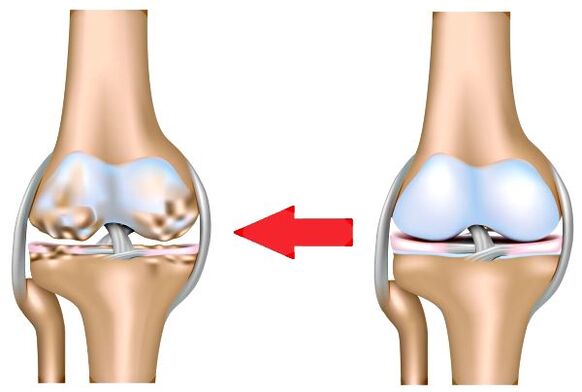
Osteoarthritis is a chronic disease of the joints of non-inflammatory etiology, leading to deformations in the affected areas
Often, the degeneration of cartilage in young people is observed, more often it can be found in men.In young girls, interfalanced arthrosis is often detected.After reaching the age of fifty, the lesion frequency and location of focus becomes about the same for representatives of both genders and is approx.60%.
From the data presented, it can be understood that it is extremely important to identify pathology in the early stages of the most effective drug therapy.Otherwise, the treatment of launched arthrosis will be inaccessible to most elderly patients in connection with the financial component.
Causes and Risk Factors for Developing Arthrosis
The frequency of the occurrence of the presented joint disease has led to the problem being acute in the medical circles in highly developed countries.Hundreds of millions of dollars are spent on studies of arthosis by leading clinics annually.The gradual study of the problem made it possible to find out the pathogenesis of the process and factors that may increase the likelihood of the occurrence of the disease.
The modern and more complete classification of common degeneration will be presented below, at this time it is enough to understand that the primary and secondary forms are characterized.
The causes that may lead to the development of a secondary joint disease include the following:
- Congenital changes associated with the blood supply to articular joints;
- damage to cartilage, ligamentous appliances or bone growth zones;
- violations associated with metabolism, especially with a mineral compound;
- Autoimmune pathologies;
- infections affecting the bone tissue;
- Hemophilia.
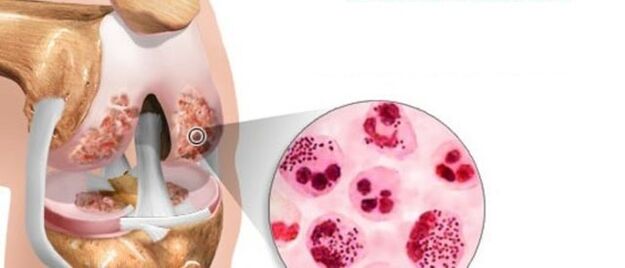
Primary arthrosis is an independent disease it can develop as a result of the impact of such provocative factors:
- Senil Age;
- the presence of excess body weight;
- Excessive physical activity;
- Surgical intervention in the joint;
- Genetic disposal;
- Inadequate alimentary intake of calcium and other minerals;
- Chronic Rus;
- Long and frequent stay at low temperatures;
- Frequent damage of the bone joint.
The mechanism of the development of arthrosis
Normal bone joints consist of two or more heads of the joint, ligamentous appliances, cartilage and synovial fluid.All of these structures provide mobility in a particular area of the musculoskeletal system without pain, they also allow the load obtained by walking and jumping, spreading it without causing damage to the body.
Artrose of the joints belongs to a group of diseases of polyetiological origin.This means that most often the cause of development is the influence of a whole complex of triggers, including professional harmfulness, overweight, the elderly and malnutrition.The pathogenesis is that certain influences lead to a significant deterioration of the blood supply and the lymph flow from the specified area.
Further, chondrocytes lose the ability for rapid regeneration and products of a normal amount of intra -articular fluid, reducing the friction of surfaces during motion.Gradually, the cartilage becomes rough and begins to wash under the influence of pressure under active body movements.
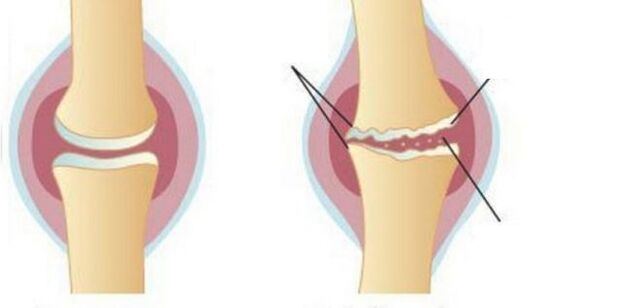
Gradually, the tissue's compensatory capacity is depleted and gradually depleted, and gradually a layer of chondrocytes is deleted.When degeneration reaches bones, pronounced pain is developed and mobility drops significantly.Without proper treatment, the patient can completely lose the ability to active movements and even independently maintain his needs.
Symptoms of arthrosis
The person does not find out what arthrosis is, the disease gradually begins and does not show up at the initial stages.Over time, the patient notes the appearance of slight pain without a particular location, which is improved on the basis of considerable physical exertion.The growing degeneration leads to the fact that the pain occurs with minor movements and gets a clear location.
Less noticeable symptoms of developing arthrosis include:
- "Sore" pain in case of weather;
- crunch when you move;
- Stiffness in the morning;
- Muscle cramps.
With a deep lesion of cartilage, there are signs that indicate local inflammation, such as swelling, redness of the skin and a local increase in temperature.If a person does not seek help from a doctor, the symptoms are progressing and begins to appear not only on the basis of physical exercises but also at rest.
The thinning of a layer of chondrocytes leads to deformation of the joints and a violation of the normal function of the limb.When one feels the pathological focus, the patient will notice the points of the greatest pain.In addition, the shower is markedly thickened along its edge, indicating compensatory hypertrophy.
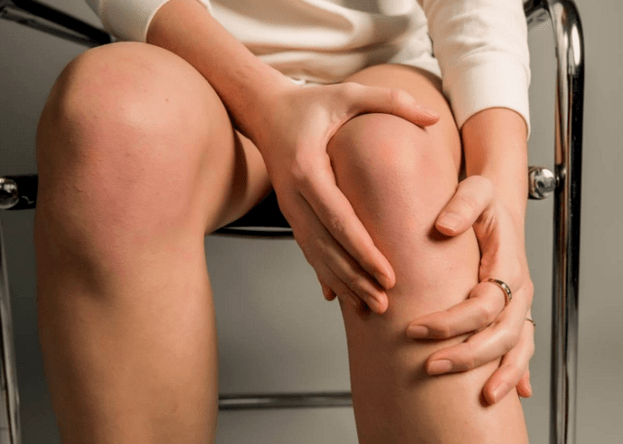
Pain
A large number of violations within bone lines lead to certain difficulties in the process of differential diagnosis.However, after evaluating the nature of the pain, arthritis can be distinguished from arthritis of another etiology.In the state described, painful sensations usually occur when trying to perform active movements.Its intensity will gradually increase when trying to increase the load on the damaged joint.
The clinical image described corresponds to the first phase of the process.On the second and third phase of progression, pain is displayed even in a state of complete rest, you can only stop them by giving a position comfortable for the limb.The difference between arthritis is the constant presence of pain that does not disappear when the position changes and also intensifies at night.
Sowearity of the joint
The destruction of the natural structure of the cartilage causes active spread of chondroblasts, but each polypotent cell in our body has a specific division boundary.This phenomenon is called a compensatory buffer.This means that after a certain amount of mitotic divisions, the cell dies and can no longer reproduce its own species.
After some time, this causes a change in the normal form of the common gap, the appearance of the so -called "Christ" or outgrowth in its lumen and recesses.This phenomenon only aggravates the process as the spikes formed during the destruction process cause additional damage during movement.
Due to the change in the smoothness of the articular surface, the appearance of tuberosity and irregularities, the amplitude of active and passive movements is significantly reduced.It is this symptom that most often causes the patient to seek medical help.Unfortunately, at this point, the effectiveness of drug treatment becomes too low, only surgical joint correction can correct the situation.

The features include:
- High probability of developing "contracture" or complete disappearance of active and passive movements in the limb;
- Stock is observed all day and not just in the morning as with arthritis;
- In some cases, the limb must be faded manually to give it a more practical position.
Sounds in the joint
Many have heard a distinctive "crisp" sound when they knead collections.There is a theory after which this phenomenon in a healthy person is observed when the pressure in the capsule of the bone in the capsule changes as a result changes the density of the synovial fluid dramatically, and the gas bubbles in it are expanded rapidly and bursting, creating a semblance of crust.This phenomenon is not dangerous, but with arthosis a similar sound appears as a result of other processes.
Crysta's cartilage formed during the destruction of cartilage and joint lip, which led to the formation of cracks and renovating the ligamentous apparatus.Even an inexperienced person will be able to distinguish the sound of the joint with arthrosis - he is more rough and "dry".The severity and volume of the symptom described is directly proportional to the disease stage.
The specific thing about sounds in the joint with arthrosis is:
- Their presence only in the dizzying joint;
- Always accompanied by a deterioration of mobility;
- Expenditure progresses in the later stages of the disease.

Changing the appearance of the joint
In the initial stages of the development of arthrosis, the process does not lead to a change in the form of bone joint.A noticeable change can only be observed with a neglected disease when one part of the joint is completely deleted and the other still produces cartilage cells.As a result, the pathological area significantly increases and loses its natural form.The specified symptom is extremely unfavorable, as the presence of deformation in the region, for example, the knee or hip connection will always lead to changes in the area of the lower structures due to the displacement of the axis of the applied load.
Types and stages of arthrosis
The modern classification of arthrosis is quite branched due to the huge list of the possible location of the pathological focus.
For the convenience of communication between specialists in various medical centers and even countries on the issue of diagnosis and treatment of this disease are the most important distinguishing:
- Osteoarthritis of the hands;
- cervical;
- ankle;
- knee;
- polyarthrosis;
- hip;
- backbone.
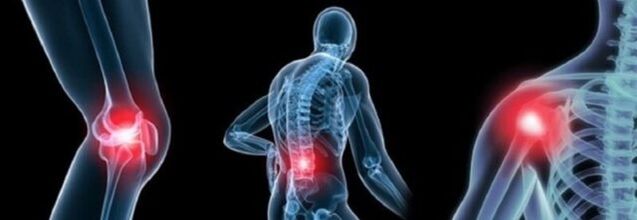
When establishing a diagnosis, a very important phase is exactly the exact determination of the stage of the destructive process.The phases of the development of arthrosis are separated:
Step 1 - There are no visible changes in the mold of the joint, disturbances are observed in the biochemical composition of the intra -articular fluid, an insignificant pain syndrome appear, supplemented with inflammatory manifestations in the joint.
Step 2 - A degenerative process is observed in the cartilage substance, "Christ" forms, stiffness and significant pain syndrome during movements are joined.Distrophy of the surrounding joint of the muscles evolves.
Step 3 - The presence of extensive focusing of cartilage is determined, the form of the joint changes, the amplitude of active and passive movements in the limbs are significantly or completely absent.Often on patients at this point, contractures develop that completely stop movements in the affected area.
Complications
An uncontrolled process of destruction can lead to serious complications that, in addition to reducing the quality of life, can lead to a complete inability to independently take care of themselves.
The most difficult include:
- Complete destruction of the articular cartilage in the joint;
- Kontractur;
- the appearance of hernial projections in the area of intervertebral discs;
- The patient's serious disability;
- Significant deformation of the limb.
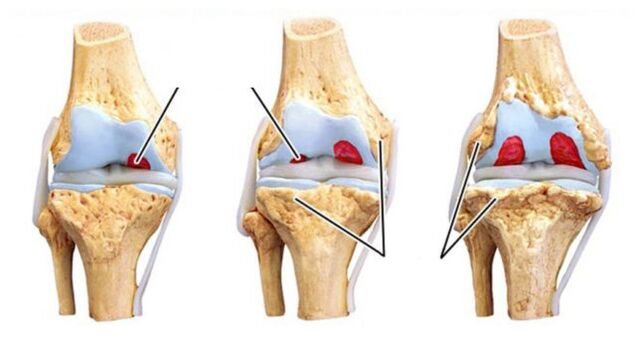
Treatment of arthrosis
Unfortunately, many patients unfortunately learn about what arthrosis is and how to treat it at these stages when a significant effect is no longer possible to achieve a significant effect.It is necessary to participate in the correction of the condition of the musculoskeletal system according to the appearance of the first symptoms and lifelongs.This is due to the fact that the effect of factors contributing to the development of the disease is rarely possible to prevent.For example, age -related changes in blood supply and lymph flow from the joint require constant use of vascular drugs.Given the pathogenesis, therapy should be complex and comprehensive.To begin with, after the appearance of unpleasant sensations as you move, refer to a specialist in the rheumatological profile or traumatologist.The doctor, based on laboratory and instrumental diagnostics, will establish an accurate diagnosis and resolve the issue of prescribing adequate treatment.
Treatment with medicine
In the early stages of arthosis you can correct the situation using medication.For this purpose, such medicine is used:
- Hormones of the adrenal cortex;
- Non -steroidal anti -inflammatory drugs;
- Preparations with chondroprotective effects.
A complex influence makes it possible to save the patient from pain, smooth the inflammatory process and restore normal blood supply in the shortest possible time.

The latest therapy
Advanced development in drug treatment led to the creation of new medicines, which essentially is replacement for natural synovial fluid.Developed molecules can significantly reduce the process of cartilage degeneration, reduce pain and save the patient from inflammatory phenomena.The artificial synovial fluid is introduced directly in the common bag every week.The duration of a course of treatment is 3-5 weeks.Usually, the result achieved is enough for the normal life of a person for 6-12 months.Patients claim that comfort and quality of life are significantly improved.Unfortunately, this tactic is only useful in relation to people with 1-2 phase of arthrosis.
Surgical treatment
With serious damage to large joints, such as hip or knee, at a relatively young age up to 60 years, patients are offered an operation for a complete replacement of the joint.Today, ceramic and titanium transplants are used that can completely recover lost functions.These devices are strong enough and are able to give the patient up to 20 years of life without problems with mobility in replaced collections.
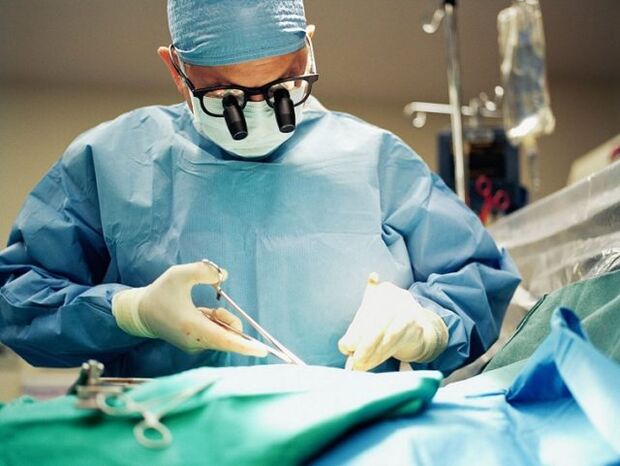
Folk recipes
Non -traditional medicine is widely used to treat arthrosis.This is due to the fact that after stopping an emergency process, lifelong therapy is required that aims to restore and maintain the natural structure of the cartilage.To achieve the dimensions, the products used must be safe and most natural as possible.
Compressions and lotions with a decoction of the following plants are very popular:
- Ginger Rod;
- cinnamon;
- Kalanchoe;
- turmeric;
- celery.
Diet with arthrosis
In the treatment of the pathology presented, it is extremely important to give the body a constant intake of nutrients.This can only be achieved if adherence to proteins, fat, carbohydrates, vitamins and micro elements of the diet with regard to the content of proteins, fat.To prepare the most sufficient circuit cycle, seek help from a nutrition physiologist.From the diet it is necessary to remove fast carbohydrates and alcohol.The basis of the table must be dishes with fish, red meat and fresh fruits.
It is very important to comply with the following nutritional rules for arthrosis:
- balance;
- Eat 5-6 times a day in small portions;
- Don't eat after 19:00;
- Get rid of excess body weight.
Prevention
There is no specific prevention of arthrosis today due to polyethiological condition.
You can warn the beginning of the disease by observing general recommendations:
- proper nutrition;
- Moderate physical activity 2-3 times a week;
- Normalization of body weight;
- Frequently fractional nutrition;
- Compliance with personal hygiene rules;
- Rejection of bad habits.
Conclusion
The presented pathological state of the musculoskeletal system is often observed in elderly patients.It is necessary to increase the frequency of early diagnosis of the disease, as it is only possible in this case to rely on a successful result from conservative treatment.The prognosis of work capacity subject to the early identification and compliance of all prescriptions of the doctor is favorable.The presence of arthrosis in the third step is accompanied by an unfavorable prognosis and can lead to the patient's complete inability to serve himself.
Nevertheless, even the most severe form of the disease is adjusted by means of surgical treatment whose disadvantages are: whose disadvantages are:
- the trauma of surgery;
- high cost;
- long rehabilitation period;
- It cannot be used for patients over 60 years old.

















































